formerly eScholarship Editions


|
|
|
|
Your search for
'Organismal Biology' in subject
found 8 book(s). | Modify Search | Displaying 1 - 8 of 8 book(s) | |
| 1. | 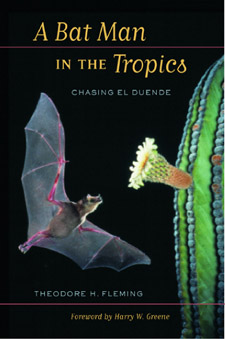 | Title: A bat man in the tropics: chasing El Duende Author: Fleming, Theodore H Published: University of California Press, 2003 Subjects: Organismal Biology | Mammalogy | Autobiography | Ecology Publisher's Description: The euphoria of discovery is the only motivation many scientists need for studying nature and its secrets. Yet euphoria is rarely expressed in scientific publications. This book, a personal account of more than thirty years of fieldwork by one of the world's leading bat biologists, wonderfully conveys the thrill of scientific discovery. Theodore Fleming's work to document the lives and ecological importance of plant-visiting bats has taken him to the tropical forests of Panama, Costa Rica, and Australia, and to the lush Sonoran Desert of northwest Mexico and Arizona. This book tells the story of his fascinating career and recounts his many adventures in the field. Fleming weaves autobiographical reflections together with information on the natural history and ecology of bats and describes many other animals and plants he has encountered. His book details the stresses and rewards of life in scientific field camps, gives portraits of prominent biologists such as Dan Janzen and Peter Raven, and traces the development of modern tropical biology. A witness to the destruction and development of many of the forests he has visited throughout his career, Fleming makes a passionate plea for the conservation of these wild places. [brief] Similar Items |
| 2. | 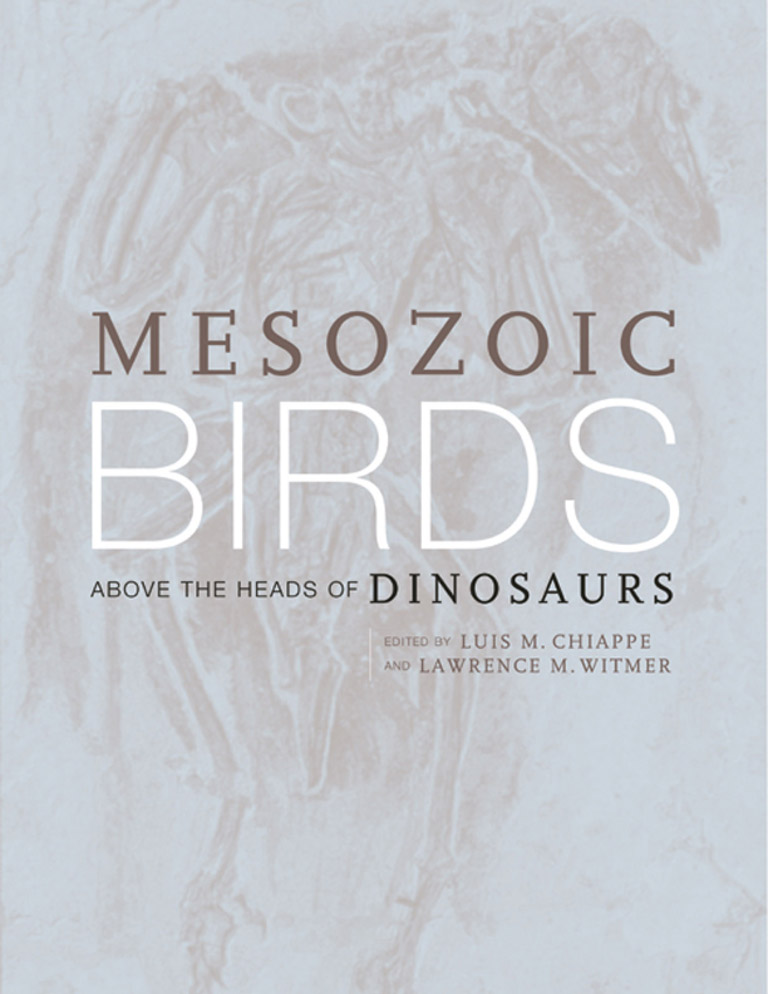 | Title: Mesozoic birds: above the heads of dinosaurs Author: Chiappe, Luis M Published: University of California Press, 2002 Subjects: Organismal Biology | Ornithology | Paleontology | Evolution Publisher's Description: Our knowledge of the origin and early evolution of birds has exploded in the past ten to fifteen years. In the 1990s alone, scientists became aware of approximately three times more species of early birds than were previously known, marking the first 85 million years of avian development as a period of remarkable species diversity. Assembling work by an international group of renowned scientists, Mesozoic Birds: Above the Heads of Dinosaurs is the most authoritative and up-to-date source on early avian evolution currently available. This unique resource provides a comprehensive examination of the known fossil record and is also an unparalleled guide to the fast-paced developments in current research. Mesozoic Birds: Above the Heads of Dinosaurs covers a wide range of topics, including discussions of avian origins, the fossil record of feathers and footprints, bone histology, and locomotor evolution. Controversial taxa such as Protoavis, Caudipteryx, and Mononykus receive special treatment. But the heart of the volume presents the anatomy, relationships, and paleobiology of the undisputed Mesozoic aviary. Some of the book's most exciting features are the new definitive descriptions and illustrations of taxa that previously have received only brief notice, such as the alvarezsaurid Shuvuuia; the enantiornithines Sinornis; Eoalulavis, Vorona, and Patagopteryx; and the hesperornithiform Enaliornis. The origin of birds and their relationship to dinosaurs continue to be hotly debated among paleontologists, ornithologists, and evolutionary biologists. This cutting-edge reference will become an essential resource for those interested in this debate and in the many other fascinating topics relating to the evolution of the earliest known birds. [brief] Similar Items |
| 3. | 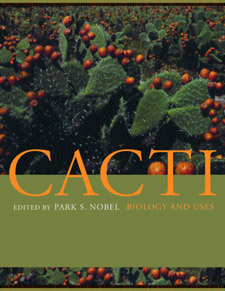 | Title: Cacti: biology and uses Author: Nobel, Park S Published: University of California Press, 2002 Subjects: Organismal Biology | EcologyEvolutionEnvironment | Botany | Plants | Agriculture Publisher's Description: The Cactaceae family, with about sixteen hundred species, is cultivated worldwide for fruits, forage, fodder, and even as a vegetable. Cacti are recognized for their attractive flowers, special stem shapes, and ability to tolerate drought. Because of their efficient use of water and other adaptations, biological and agronomic interest in cacti has soared. These fascinating plants also have much to teach us about biodiversity and conservation. Yet a current, synthetic, wide-ranging reference on cacti has not been available until now. This comprehensive book, compiled by a well-known cactus biologist, includes authoritative, up-to-date chapters by thirty-five contributors from around the world on topics ranging from evolution to biotechnology. It is the first book of its kind to compile information on cactus biology, ecology, and uses in one convenient place. The first half of the book provides a thorough overview of cactus biology and morphology and discusses the environmental and conservation issues that affect the plants. It includes a discussion of the evolution of the family, paying particular attention to new genetic and molecular approaches. The second half of the book focuses on the practical concerns of cultivating cacti, such as pest control and diseases, horticultural and forage applications, and techniques for agronomy. Other chapters cover the different markets for cacti and products that are made from them. This unique volume will be a reliable and informative reference for ecologists and environmentalists, agriculturists, plant biologists, and anyone seriously interested in these remarkable plants. [brief] Similar Items |
| 4. | 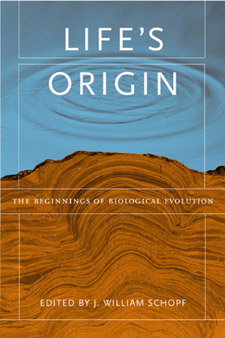 | Title: Life's origin: the beginnings of biological evolution Author: Schopf, J. William 1941- Published: University of California Press, 2002 Subjects: Organismal Biology | Paleontology | Astronomy | Evolution | Earth Sciences | Physical Sciences Publisher's Description: Always a controversial and compelling topic, the origin of life on Earth was considered taboo as an area of inquiry for science as recently as the 1950s. Since then, however, scientists working in this area have made remarkable progress, and an overall picture of how life emerged is coming more clearly into focus. We now know, for example, that the story of life's origin begins not on Earth, but in the interiors of distant stars. This book brings a summary of current research and ideas on life's origin to a wide audience. The contributors, all of whom received the Oparin/Urey Gold Medal of the International Society for the Study of the Origin of Life, are luminaries in the fields of chemistry, paleobiology, and astrobiology, and in these chapters they discuss their life's work: understanding the what, when, and how of the early evolution of life on Earth. Presented in nontechnical language and including a useful glossary of scientific terms, Life's Origin gives a state-of-the-art encapsulation of the fascinating work now being done by scientists as they begin to characterize life as a natural outcome of the evolution of cosmic matter. [brief] Similar Items |
| 5. | 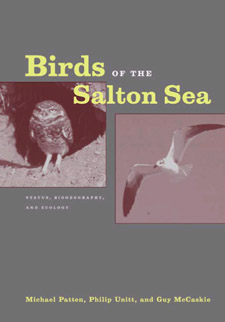 | Title: Birds of the Salton Sea: status, biogeography, and ecology Author: Patten, Michael A Published: University of California Press, 2003 Subjects: Organismal Biology | Ecology | Ornithology | Animals | California and the West Publisher's Description: The Salton Sea, California's largest inland lake, supports a spectacular bird population that is among the most concentrated and most diverse in the world. Sadly, this crucial stopover along the Pacific Flyway for migratory and wintering shorebirds, landbirds, and waterfowl is dangerously close to collapse from several environmental threats. This book is the first thoroughly detailed book to describe the birds of Salton Sea, more than 450 species and subspecies in all. A major contribution to our knowledge about the birds of western North America, it will also be an important tool in the struggle to save this highly endangered area. Synthesizing data from many sources, including observations from their long-term work in the area, the authors' species accounts discuss each bird's abundance, seasonal status, movement patterns, biogeographic affinities, habitat associations, and more. This valuable reference also includes general information on the region's fascinating history and biogeography, making it an unparalleled resource for the birding community, for wildlife managers, and for conservation biologists concerned with one of the most threatened ecosystems in western North America. [brief] Similar Items |
| 6. | 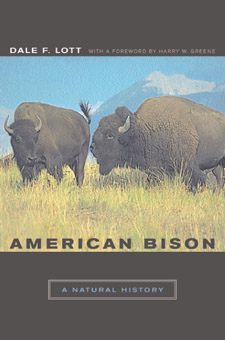 | Title: American bison: a natural history Author: Lott, Dale F Published: University of California Press, 2002 Subjects: Organismal Biology | Mammalogy | Animals | Animal Behavior | Science | Natural History Publisher's Description: American Bison combines the latest scientific information and one man's personal experience in an homage to one of the most magnificent animals to have roamed America's vast, vanished grasslands. Dale F. Lott, a distinguished behavioral ecologist who was born on the National Bison Range and has studied the buffalo for many years, relates what is known about this iconic animal's life in the wild and its troubled history with humans. Written with unusual grace and verve, American Bison takes us on a journey into the bison's past and shares a compelling vision for its future, offering along the way a valuable introduction to North American prairie ecology. We become Lott's companions in the field as he acquaints us with the social life and physiology of the bison, sharing stories about its impressive physical prowess and fascinating relationships. Describing the entire grassland community in which the bison live, he writes about the wolves, pronghorn, prairie dogs, grizzly bears, and other animals and plants, detailing the interdependent relationships among these inhabitants of a lost landscape. Lott also traces the long and dramatic relationship between the bison and Native Americans, and gives a surprising look at the history of the hide hunts that delivered the coup de grâce to the already dwindling bison population in a few short years. This book gives us a peek at the rich and unique ways of life that evolved in the heart of America. Lott also dismantles many of the myths we have created about these ways of life, and about the bison in particular, to reveal the animal itself: ruminating, reproducing, and rutting in its full glory. His portrait of the bison ultimately becomes a plea to conserve its wildness and an eloquent meditation on the importance of the wild in our lives. [brief] Similar Items |
| 7. | 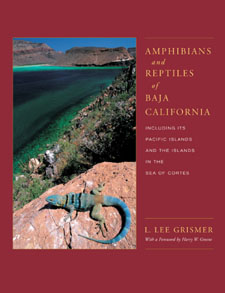 | Title: Amphibians and reptiles of Baja California, including its Pacific islands, and the islands in the Sea of Cortés Author: Grismer, L. Lee 1955- Published: University of California Press, 2002 Subjects: Organismal Biology | Natural History | California and the West | Herpetology Publisher's Description: The Baja California peninsula is home to many forms of life found nowhere else on earth. This, combined with the peninsula's rugged and inaccessible terrain, has made the area one of the last true biological frontiers of North America. L. Lee Grismer is not only the foremost authority on the amphibians and reptiles of Baja California, but also an outstanding photographer. He has produced the most comprehensive work on the herpetofauna of the peninsula and its islands ever published. With its stunning color images, detailed accounts of many little-known species, and descriptions of the region's diverse environment, this is the definitive guide to the amphibians and reptiles of a fascinating and remote region. The culmination of Grismer's quarter century of fieldwork on the Baja peninsula and his exploration of more than one hundred of its islands in the Pacific Ocean and the Sea of Cortés, this book gives information on the identification, distribution, natural history, and taxonomy of each species of amphibian and reptile found there. Preliminary accounts of the life history of many of the salamanders, frogs, toads, turtles, lizards, and snakes are reported here for the first time, and several species that were almost unknown to science are illustrated in full color. The book also contains new data on species distribution and on the effect of the isolated landscape of the peninsula and its islands on the evolutionary process. Much of the information gathered here is presented in biogeographical overviews that consider the extremely varied environments of Baja California in both a contemporary and a historical framework. An original and important contribution to science, this book will generate further research for years to come as it becomes a benchmark reference for both professionals and amateurs. [brief] Similar Items |
| 8. | 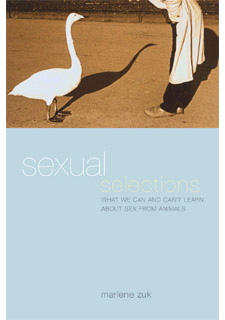 | Title: Sexual selections: what we can and can't learn about sex from animals Author: Zuk, M. (Marlene) Published: University of California Press, 2002 Subjects: Organismal Biology | Cultural Anthropology | Evolution | Gender Studies | Animal Behavior | Sociology | Biology Publisher's Description: Scientific discoveries about the animal kingdom fuel ideological battles on many fronts, especially battles about sex and gender. We now know that male marmosets help take care of their offspring. Is this heartening news for today's stay-at-home dads? Recent studies show that many female birds once thought to be monogamous actually have chicks that are fathered outside the primary breeding pair. Does this information spell doom for traditional marriages? And bonobo apes take part in female-female sexual encounters. Does this mean that human homosexuality is natural? This highly provocative book clearly shows that these are the wrong kinds of questions to ask about animal behavior. Marlene Zuk, a respected biologist and a feminist, gives an eye-opening tour of some of the latest developments in our knowledge of animal sexuality and evolutionary biology. Sexual Selections exposes the anthropomorphism and gender politics that have colored our understanding of the natural world and shows how feminism can help move us away from our ideological biases. As she tells many amazing stories about animal behavior--whether of birds and apes or of rats and cockroaches--Zuk takes us to the places where our ideas about nature, gender, and culture collide. Writing in an engaging, conversational style, she discusses such politically charged topics as motherhood, the genetic basis for adultery, the female orgasm, menstruation, and homosexuality. She shows how feminism can give us the tools to examine sensitive issues such as these and to enhance our understanding of the natural world if we avoid using research to champion a feminist agenda and avoid using animals as ideological weapons. Zuk passionately asks us to learn to see the animal world on its own terms, with its splendid array of diversity and variation. This knowledge will give us a better understanding of animals and can ultimately change our assumptions about what is natural, normal, and even possible. [brief] Similar Items |